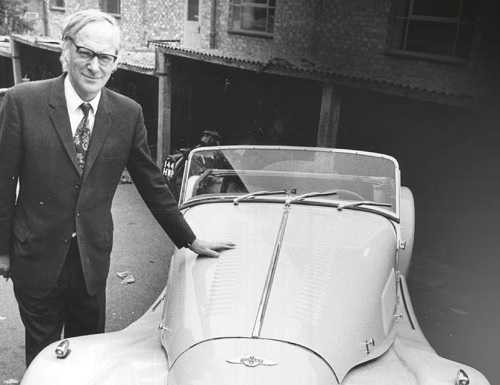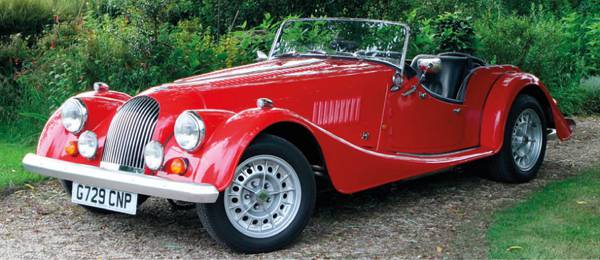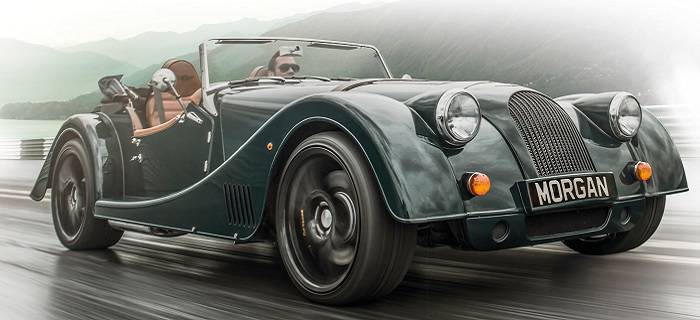The Morgan Motor Company, based in the English county of Worcestershire, has turned old-fashioned quirkiness into an art form. Still independently owned, the firm continues to build sports cars with a heritage dating back to the 1930s, in a factory complex that opened in 1914.

Morgan founder Harry “H.F.S.” Morgan started his engineering career working for the Great Western Railway before setting up a garage selling and repairing cars. In 1909, he built his first car, a single seater with one wheel at the back, tiller steering, and a V-twin Peugeot engine. This basic, but carefully engineered little vehicle was one of the first “Cyclecars.”
Morgan launched a production version with limited sales success, thanks to the tiller and single seat, but the car’s performance and toughness won praise, and when two-seater versions with steering wheels appeared, demand grew quickly. In fact, his design template was widely copied, but rivals generally struggled to meet his cars’ standards.
The Morgan’s reliability and verve, along with handling that was safer than other three-wheelers, made this little tricycle a popular competition car, and a performance version, the Grand Prix, was built. Soon, Morgans were familiar and successful sights on racetracks such as Brooklands, where they beat much bigger, more powerful cars.
Morgan was to use a variety of engines for its three-wheelers, but had particular success with JAP, which had water-cooled V-twins. Its cars were chain-driven with two-speed transmissions, and many of the controls, including the throttle, were operated from levers on the steering wheel. Later Morgans gained refinements, such as a third gear, reverse, and front brakes, which were needed for models such as the Super Sport. This could manage around 80 mph (129 km/h) in 1927.

By the 1930s, Morgan was fighting competition from four-wheeled sports cars, like the MG M-type Midget, which had more creature comforts and conventional driving controls. The advent of its new F-type three-wheeler in 1933 saw Morgan use Ford 8 hp car engines and conventional transmissions.
In 1936, Morgan built its first four-wheeler, the engaging little 4/4. With independent front suspension and a light body, the 1,100 cc car handled well and could hit 75 mph (121 km/h). Its design template is still evident in many of today’s Morgans.
World War II saw the Morgan factory making aircraft parts, but car production got underway again in 1946. The firm now concentrated on four-wheelers, which eventually featured more powerful Standard Vanguard engines that would soon be shared with rival Triumph TR sports cars.
Morgans won the 1951 and ‘52 RAC Rally team awards with Harry Morgan’s son Peter at the wheel. Peter eventually took over the company in 1959.
In 1963, Morgan tried to update its image with the Plus 4 Plus, a pretty coupe with a fiberglass body, but just 26 were ultimately made. In 1968, Morgan put Rover’s high-performance 3.5-liter V8 engine into the Plus 4 and created the legendary Plus 8.

To this day, Morgan still builds modern versions of the 4/4, with its ash-framed body and separate chassis, but in 2000 it launched the Aero 8, a companion model with a 4.4-liter BMW, V8 engine, aluminum body, and modern bonded aluminum chassis. Morgan has since continued refining this design alongside the traditional models, and in 2008 revealed a fuel cellpowered one-off called the LIFE Car, propelled by four electric motors, and with 367 bhp.
The company is also building a modern interpretation of its classic three-wheeler, with a 1,983 cc, American S&S V-twin engine, mated to a five-speed Mazda transmission, so owners of these insect-like vehicles have the luxury of reverse gear. With a top speed of 115 mph (185 km/h), it continues the Morgan tradition of moving quickly on just one wheel at the back, and is a big success for the company. Many famous, low-volume performance automakers have gone bust or been bought out, but Morgan continues to stand alone.